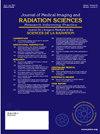The cost of perfection: An investigation into the unnecessary rejection of clinically acceptable lateral wrist imaging
IF 2
Q3 RADIOLOGY, NUCLEAR MEDICINE & MEDICAL IMAGING
Journal of Medical Imaging and Radiation Sciences
Pub Date : 2024-10-01
DOI:10.1016/j.jmir.2024.101489
引用次数: 0
Abstract
Introduction
This study illustrates image rejection rates of the lateral wrist x-ray projection at a large, public teaching hospital. Rejected images were evaluated to determine the number of images where image repeat was required based on the clinical indication. This study highlights the difference in subjective image-repeat decision-making skills existing between radiologists, experienced radiographers and junior radiographers.
Methods
A retrospective review was conducted of all rejected lateral wrist x-ray images by a panel of 3 radiologists, 3 experienced radiographers and 6 junior radiographers. This review aimed to determine if rejected imaging met the consideration of the clinical indication and assumed appropriate acquisition of an orthogonal projection. A compliment of images that had not been rejected were included in the review.
Results
The review demonstrated 85.8% of rejected images were deemed to meet clinical requirements according to radiologists. The experienced radiographers agreed with radiologists regarding 75.3% of images. Junior radiographers agreed with radiologists in 34.2% of cases. Junior radiographers were three times more likely to seek repeat imaging than the radiologists and experienced radiographers.
Conclusion
This review demonstrated a lateral wrist projection reject rate of 38.7% with unnecessary repeats according to clinical indications in 85.8% of cases. The review of experienced radiographers was comparable to radiologists, however, difference in decision making skills was evident in the junior radiographers. This highlights an alarming trend, should similar results be demonstrated at other health services. Inclusion of clinical reasoning for imaging and the need for repeat imaging is recommended for radiography training programs.
完美的代价对不必要地拒绝接受临床上可接受的腕关节侧位成像的调查
导言:本研究说明了一家大型公立教学医院腕关节侧位 X 光投影的图像拒绝率。通过评估被拒绝的图像,确定根据临床指征需要重复成像的图像数量。这项研究强调了放射科医生、经验丰富的放射技师和初级放射技师在主观图像重复决策技能方面存在的差异。方法由 3 名放射科医生、3 名经验丰富的放射技师和 6 名初级放射技师组成的小组对所有被拒的腕关节侧位 X 光图像进行了回顾性审查。审查的目的是确定被拒绝的影像是否符合临床适应症的要求,并假定获取正交投影是适当的。审查结果表明,放射科医生认为 85.8% 的被拒图像符合临床要求。经验丰富的放射技师在 75.3% 的图像上与放射医师意见一致。初级放射技师与放射科医生意见一致的占 34.2%。结论本次审查显示,腕部侧位投影的拒收率为 38.7%,其中 85.8% 的病例根据临床适应症进行了不必要的重复检查。经验丰富的放射技师的复查结果与放射科医生不相上下,但初级放射技师的决策技能明显不同。如果其他医疗服务机构也出现类似结果,这将是一个令人担忧的趋势。建议在放射学培训课程中加入成像的临床推理和重复成像的必要性。
本文章由计算机程序翻译,如有差异,请以英文原文为准。
求助全文
约1分钟内获得全文
求助全文
来源期刊

Journal of Medical Imaging and Radiation Sciences
RADIOLOGY, NUCLEAR MEDICINE & MEDICAL IMAGING-
CiteScore
2.30
自引率
11.10%
发文量
231
审稿时长
53 days
期刊介绍:
Journal of Medical Imaging and Radiation Sciences is the official peer-reviewed journal of the Canadian Association of Medical Radiation Technologists. This journal is published four times a year and is circulated to approximately 11,000 medical radiation technologists, libraries and radiology departments throughout Canada, the United States and overseas. The Journal publishes articles on recent research, new technology and techniques, professional practices, technologists viewpoints as well as relevant book reviews.
 求助内容:
求助内容: 应助结果提醒方式:
应助结果提醒方式:


